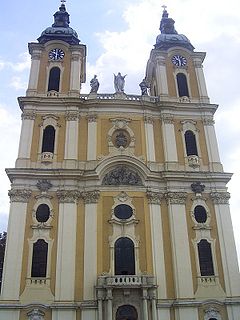Related Research Articles

Bihar was an administrative county (comitatus) of the Kingdom of Hungary and a county of the Eastern Hungarian Kingdom and Principality of Transylvania. Most of its territory is now part of Romania, while a smaller western part belongs to Hungary. The capital of the county was Nagyvárad.

Csongrád-Csanád is the name of an administrative county in southern Hungary, straddling the river Tisza, on the border with Serbia and Romania. It shares borders with the Hungarian counties Bács-Kiskun County, Jász-Nagykun-Szolnok County and Békés. The administrative centre of Csongrád-Csanád county is Szeged. The county is also part of the Danube–Criș–Mureș–Tisa Euroregion euroregion.

Arad County was an administrative unit in the Kingdom of Hungary, the Eastern Hungarian Kingdom and the Principality of Transylvania. The county was established along the Maros (Mureș) river in the 11th or the 12th century, but its first head, or ispán, was only mentioned in 1214. Its territory is now part of Romania, except a small area which is part of Hungary. The capital of the county was Arad.

Ajtony, Ahtum or Achtum was an early-11th-century ruler in the territory now known as Banat in present Romania and Serbia. His primary source is the Long Life of Saint Gerard, a 14th-century hagiography. Ajtony was a powerful ruler who owned many horses, cattle and sheep and was baptised according to the Orthodox rite in Vidin. He taxed salt which was transferred to King Stephen I of Hungary on the Mureș River. The king sent Csanád, Ajtony's former commander-in-chief, against him at the head of a large army. Csanád defeated and killed Ajtony, occupying his realm. In the territory, at least one county and a Roman Catholic diocese were established.

Fajsz, also Falicsi, was Grand Prince of the Hungarians from about 950 to around 955. All information on him comes from De administrando imperio, a book written by the Byzantine Emperor Constantine VII Porphyrogenitus. No other contemporary source or later Hungarian chronicle preserved his name, suggesting that he did not take an active role in the politics of the Hungarian tribes' confederation.

The Roman Catholic Archdiocese of Kalocsa–Kecskemét is an archdiocese of the Latin Rite of the Roman Catholic Church in Hungary. The diocese is the metropolitan of the Diocese of Pécs and the Diocese of Szeged–Csanád. Its patron saint is Saint Paul. The current archbishop is Balázs Bábel, who was appointed in 1999.

The Hodoș-Bodrog Monastery is one of the oldest monastic institutions in Romania. It was originally a Roman Catholic (Benedictine) monastery, built before 1177 and destroyed before 1293. The present monastery, which belongs to the Romanian Orthodox Church, was built near the ruins of the first monastery in the late 14th or early 15th century.

This article discusses the administrative divisions of the Kingdom of Hungary between 1941 and 1945. As a result of the First (1938) and Second Vienna Award (1940), territories that had been ceded by the Kingdom of Hungary at the 1920 Treaty of Trianon were partly regained from Czechoslovakia and Romania respectively. This required modification of the administrative divisions.

The Middle Ages in the Banat started around 900. Around that time, Duke Glad ruled Banat, according to the Gesta Hungarorum. Archaeological finds and 10th-century sources evidence that Magyars settled in the lowlands in the early 10th century, but the survival of Avar, Slav and Bulgar communities can also be documented. A local chieftain, Ajtony, converted to Eastern Orthodoxy around 1000, but his attempts to control the delivery of salt on the Mureș River brought him into conflict with Stephen I of Hungary. Ajtony died fighting against the royal army in the first decades of the 11th century. His realm was transformed into a county of the Kingdom of Hungary. Counties were the most prominent units of royal administration.
Otto (Atha) from the kindred Győr was a Hungarian noble, who served as palatine in 1066, during the reign of Solomon, King of Hungary. He was the ancestor of the gens Győr, which flourished until the 17th century.
The Arad Chapter was a collegiate chapter, established in the 12th century, in the Kingdom of Hungary. It was dedicated to Saint Martin of Tours. The chapter was under the direct jurisdiction of the archbishop of Esztergom. It held landed property in at least seven counties. From the 1220s, the chapter was a place of authentication.

The Dömös Chapter was a collegiate chapter, established around 1107, in the Kingdom of Hungary. It was dedicated to Saint Margaret of Antioch.

The Kolozsmonostor Abbey was a Benedictine Christian monastery at Kolozsmonostor in Transylvania in the medieval Kingdom of Hungary. According to modern scholars' consensus, the monastery was established by Ladislaus I of Hungary before 1095.
Megyei Bajnokság I is the fourth tier of Hungarian football league system. It includes the championships of the 20 counties of Hungary. The champions might be promoted to the Nemzeti Bajnokság III.
Hungarian local elections were held in Hungary on 13 October 2019. Mayors and assembly members will be elected for a term of 5 years.
References
- 1 2 Rokay & Takács 1994, p. 677.
- ↑ Kiss 2013, p. 86.
- ↑ Györffy 1987, p. 241.